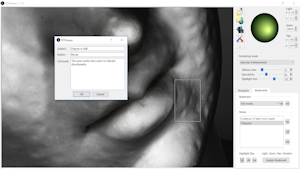
RTI creates visualisations of data constructed from two familiar visual concepts: photographs and light. In addition to exploring the potential of RTI for analysis and interpretation of artefacts, the Mary May project was interested in exploring the significance of these two concepts for visualisation of information through the use of a case study.
As described earlier in this article, information from several photographs is combined as part of the creation of an RTI. The resultant interactive file uses conventions from photography to present an interactive synthetic image that can be manipulated to visually represent the information recorded. The PTM is a way to interactively re-light a simulated surface that has been derived from digital photographs. This simulated output has been derived from photographs using a complex set of algorithms, and so despite its apparent similarity to the original set of photographs, the resultant PTM bears no straightforward relationship to the original images. A severance between the captured images and the PTM output has occurred. There is a mathematical relationship present, but this is not human-readable. The theory of computational visualisation as a form of scientific enquiry is beyond the scope of this article (see Johnson 2004 and Gilbert et al. 2008); however, as RTIs rely heavily on the meme of the photograph, it is necessary to dedicate some space to this form of interaction with data.
An RTI presents data in a recognisable form, in the way that Berger refers to photographs that have been modified as a 'lie' (1989). In doing so, an RTI presents specularity through a falsehood. Time and again in workshops training heritage professionals to use RTI, Smith has described the output PTM as a combination of 50 photographs. This misrepresentation of the true nature of the PTM is not necessarily problematic, as it serves to describe a complex algorithmic series of tasks in using a familiar trope to the audience. In the same way that three-dimensional (3D) reconstructions of historical buildings use cinematic conventions to present fly-throughs of long-gone streets presented two-dimensionally on a screen, this approach to PTMs as an interactive combination of a set of photographs is constructing a relationship between the collection and representation of scientific data through established conventions from elsewhere.
In the case of 3D reconstructions, the difficulty of presentation of uncertainty is being debated by archaeologists (Bentkowska-Kafel et al. 2012). As a way to cope with this necessary medium of presenting whole rather than partial objects, visual cues or additional layering of information have sometimes been adopted as signifiers of ambiguity of details extrapolated from incomplete data (Zuk et al. 2005). For RTI, there are currently no conventions to hint at the untrue nature of the PTM output.
The need for the theorisation of algorithms is highlighted in our use of PTMs to 'see' the invisible. Galloway argues that, in using an algorithm, we are: 'learning, internalizing, and becoming intimate with it' (2006, 90). The algorithms that produce a light-position file for the production of a PTM have an assumed objectivity and are inseparable from the practice of recording an RTI. This is in line with Gillespie's dimensions of the algorithm (2014). As such, this article is a response to Kitchin and Dodge's call (2011) to develop critical scholarship around the use of software to carry out tasks.
Crucially, PTMs could seem to be a method for recording information from an artefact that acknowledges the situation, more than a static photograph. A PTM seems to present a way to include additional information from the original context of the object, most significantly, the surface textures. Shanks has discussed the issue of the subjectivity of the photograph, particularly when used as a note or record (1997, 75-76). The ability to interactively change the lighting of a PTM seems to be a way to engage with the 'ambience' (Shanks 1997, 80) of the originating scene. The use of photography, however, as a convention for the representation of PTMs does not seem to currently allow for the representation of uncertainty. It distances the input data from output file. The use in this article of static images from PTMs, combined with descriptions of decisions behind each image alongside the actual PTMs themselves, is an attempt to provide these signifiers of uncertainty to the viewer.

As a way to facilitate transparency, our methodology for recording included the use of the annotation tool within RTIViewer to document decision-making from the recording day. The annotation tool was developed out of the Reflectance Transformation Imaging Systems for Ancient Documentary Artefacts project (Earl et al. 2011) and provides a way to mark-up views within PTM files with additional information. The annotation tool is intended to enable recording of alternative interpretations of PTMs (Earl et al. 2011, 151), but in the context of the Mary May RTI project it facilitated transparency of process. Figure 24 shows a screen capture of the annotation tool in use.
Download RTI and associated Bookmarks to view annotations in RTIViewer 1.1 (recommended)
Internet Archaeology is an open access journal based in the Department of Archaeology, University of York. Except where otherwise noted, content from this work may be used under the terms of the Creative Commons Attribution 3.0 (CC BY) Unported licence, which permits unrestricted use, distribution, and reproduction in any medium, provided that attribution to the author(s), the title of the work, the Internet Archaeology journal and the relevant URL/DOI are given.
Terms and Conditions | Legal Statements | Privacy Policy | Cookies Policy | Citing Internet Archaeology
Internet Archaeology content is preserved for the long term with the Archaeology Data Service. Help sustain and support open access publication by donating to our Open Access Archaeology Fund.